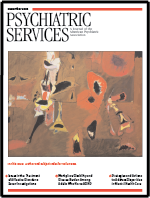To the Editor: Standardized programs for families of persons with serious mental illness can reduce the risk of relapse, enhance social functioning, and cut costs (
1,
2). Practice guidelines (
3) and the President's New Freedom Commission strongly recommend family involvement. However, very few families receive services (
3). Numerous reasons for the lack of family services exist, and engaging families is a major challenge.
For the past six years, the Oklahoma City Veterans Affairs (VA) Medical Center has provided the SAFE Program (Support and Family Education), a series of 18 psychoeducational workshops for families of veterans with serious mental illness (
4). Ninety-minute sessions are provided monthly by a psychologist to educate and support families. (The curriculum is available at http://w3.ouhsc.edu/safeprogram.) Although the program is positively received, families of only 5 percent of veterans with serious mental illness have participated. The purpose of this project was to study the efficacy of three engagement strategies.
All veterans who were receiving outpatient mental health care between January and October 2004 from one psychiatrist at the Oklahoma City VA Medical Center were invited to participate. To be included in the study the veteran's family had to live within 90 miles of the medical center and the veteran had to have a diagnosis of a serious mental illness or posttraumatic stress disorder (PTSD). Veterans were excluded if they were imminently dangerous or had acute psychosis.
Of the 527 eligible veterans, 363 (69 percent) had regular contact with a family member who lived within 90 miles. Of these 363 veterans, 165 (46 percent) allowed a family member to be contacted. Most of the 165 veterans were male (152 participants, or 92 percent). The mean±SD age was 57.62±11.48 years, and most were white (154 participants, or 93 percent). The most common diagnoses were major depression (74 participants, or 45 percent), PTSD (48 participants, or 29 percent), and schizophrenia (15 participants, or 9 percent). The family members most commonly identified were the wife (128 participants, or 78 percent) and the mother (eight participants, or 5 percent).
If the veteran consented to participate in the study, the psychiatrist provided a SAFE Program pamphlet and encouraged the veteran to ask a family member to participate. Veterans were then assigned to one of three engagement strategies: pamphlet only (no subsequent contact), pamphlet plus letter (after the appointment, a letter was sent describing ways to participate, emphasizing potential benefits, and encouraging the family to call the principal investigator), and pamphlet plus letter plus phone call (the principal investigator called the family after the letter was sent and invited the family to attend the SAFE Program). The veterans were assigned in a stepwise design (55 veterans per condition). The psychiatrist was blind to the assignment procedures. Dependent variables included a phone call by a family member to the principal investigator and any participation by a family member within six months after the invitation—that is, a family member's attendance at a SAFE Program session, a family member's accompanying a veteran to an appointment, or a request for family therapy.
There was minimal response to all three engagement strategies as measured by both dependent variables, and no significant differences were found between groups. In the pamphlet-only condition, no family members contacted the principal investigator, and family members of four veterans (7 percent) attended a program session, accompanied a veteran to an appointment, or requested family therapy. In the pamphlet-plus-letter condition, a family member of one veteran (2 percent) contacted the principal investigator, and family members of seven veterans (13 percent) attended a program session, accompanied a veteran to an appointment, or requested therapy. In the third condition, family members of two veterans (4 percent) contacted the principal investigator, and family members of four veterans (7 percent) attended a program session, accompanied a veteran to an appointment, or requested therapy.
Engaging families in the treatment of persons with serious mental illness is a complex, multidetermined process, and simple solicitations were ineffective in this study. These findings have limited generalizability, because the study was conducted at one hospital. However, the findings suggest that providers may need to accommodate families' needs by providing services in flexible, creative ways.

